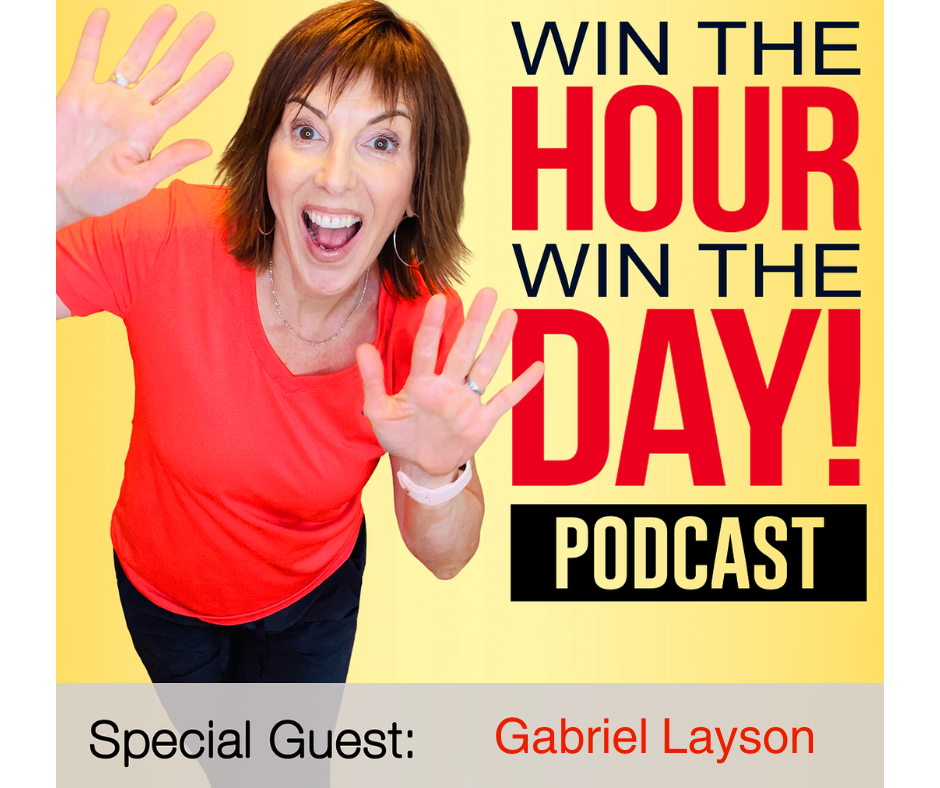Episode Summary
Ken talks frankly about the struggles of being a creative with a lot of pre and post production work. Listen in as we talk shop, and he opens up about his struggles and why he almost quit!
Learn:
-the big cost of being self employed
-what makes you an entrepreneur
-how to increase your income
Join The Community: https://www.facebook.com/groups/WinTheHourWinTheDay/
Win The Hour, Win The Day! www.winthehourwintheday.com
Podcast: Win The Hour, Win The Day Podcast
Facebook: https://www.facebook.com/winthehourwintheday/
LinkedIn: https://www.linkedin.com/company/win-the-hour-win-the-day-podcast
Ken Branson can be reached at:
MasterMIND Productions
https://www.linkedin.com/in/mmproductions/
https://www.instagram.com/kenbranson/
https://www.instagram.com/mmpevents/
https://www.facebook.com/kwbranson/
Ken Branson NYB Podcast – Timestamp Transcription
LEGEND:
GREEN – best lines of the guest
CYAN – Links to the guest business
YELLOW – Introduction of the guest
ORANGE- Quotes of the guest
RED – opening teaser
Kris: (05:18)
Hey everyone. Welcome to now your business. I’m Kris Ward and I am super excited to have our next guest here. He is an amazing talent. Ken Branson is a published photographer, an independent filmmaker. He’s earned close to a million dollars from visual storytelling after starting from the basement of his church. Some of his clients include Google, AARP, Cisco, and a host of national international organizations, churches, colleges, and universities. Through therapy and the journey of self discovery can learn that the negative drama he attracted in his life could redirected into a healthier and more profitable form of drama. Storytelling. This basement level strength is continually being refined. Every day is Ken makes a full time living, helping businesses and organizations get their message out through effective storytelling. Welcome to the show, Ken.
Ken: (06:17)
Thanks for having me.
Kris: (06:19)
All right, like in case three seconds. And you haven’t guessed Ken has a very pronounced and effective radio voice. Everything he says is just going to sound so intelligent. I think so. Now he’s now he’s afraid to talk cause I’ll openly mock him. Okay Ken. So what we’re going to do today is something really special, I think because this is something that comes across my desk a lot. For those of you who don’t know, I have a book called Win The Hour, Win The Day and a platform to go with that. And what we do in there is we really talk about business should be fun. Leveraging your time, really tripling your time off and doubling your income. And that I think business is not about the grind and that it should be fun. It should support your life, not consume it. And a big part of that is if you really want to understand productivity, it’s not about being on some time management diet, it’s about building a team. And a team really is the fundamental backbone to any successful business in the history of successful businesses. So what we’re going to do today, Ken is agreed, uh, cause he is quite a talent. I can’t wait for you to check him out online. His work just, it just breathes life right off the screen. It’s amazing. So what we’re going to talk to Ken about today is where he’s at in his business and we’re going to talk about what it would be like, you know, the pain points of starting a team, building a team, what you’ve done so far Ken, because we had a little chat earlier and what happened was you are just um, uh, amplifying what I hear so often from so many people. So I thought this would be a great conversation for the listeners. So Ken, welcome to the show.
Ken: (08:03)
Thank you. Thanks again. It’s a pleasure to be here. Um, I think it’s a great opportunity for us both. Uh, let’s rock and roll.
Kris: (08:11)
Okay. So Ken, give people a little basic rundown of what your work week looks like. So when you’re out doing photography and videography, that’s really time consuming and most people don’t understand that the amount of pre and post production that goes with any assignment. So why don’t you tell us a little bit about the demands of that?
Ken: (08:31)
Absolutely. So pre production, um, I mean as far as going and get the client first and foremost, once you get the client right, uh, once you book the client is a matter of logistics to figure out what team members need to be in place, um, where, what time, um, actually what are we going to be doing when we get there? Um, all that stuff is, is, is the game. Um, then of course during game time is capturing the event, making sure no memory cards fail, right? Cause uh, somebody’s wedding or even is, is as capturing nothing but zeros and ones in the form of inflammation on a car. Right? So making sure the technology doesn’t fail. Um, you know, uh, more stressors on top of stressors. Um, after the event is over. Of course harvesting.
Kris: (09:19)
Can I jump in? Sometimes I’m going to interrupt you. I apologize. What I want to stress with what you just said though is somebody else. If I show up for a meeting with a potential client, that’s one thing. But when you’re showing up, people are dressed and ready and they put a lot of prep work in themselves, you know, to be there. So it’s like Showtime.
Ken: (09:37)
Absolutely.
Kris: (09:38)
Right. Okay. It’s a diff, It’s a different ballgame than the rest of us showing up to say, okay, let me look at your website. Right. Okay, go ahead. Go ahead.
Ken: (09:47)
Um, so on top of, uh, you know, all the stresses that come with capturing the event or, you know, whatever we capturing, um, harvesting footage, um, it’s another very, very important stepdad, you know, we, you know, must capitalize on, um, if it’s not captured in his stored in a proper manner, um, then, you know, it’s, it’s a world of craziness afterwards. So, um, after that it’s, it’s time to do some post-production. Um, if everything went according to plan, um, the reproduction, the day of the event at the event, the in post production is kind of an, it’s sort of an ease. Um, you know, um, editing is probably for every hour we spend on the field. We probably spend about four hours editing or you know, doing post production work too. It’s a rule of thumb. So, um, and then deliver it to the client and hopefully we won’t have to do any revisions afterwards, you know, because we paid attention and listened and executed on their wishes and desires and reproduction.
Kris: (10:47)
Right? So let me just stop there. So there’s a lot of more pregame work in your industry than most, and the pressures on because you’re right, all you need is one little wire or one computer not to connect and now you just, you’re not going anywhere, right? Not going anywhere quickly. And then that recipe of per one hour, there’s four hours of pre post production. Is that what you said? Okay. So then what happens is if you’re in the ideal business and you want to make, you know, good revenue and anytime that you’re not, you know, really out there doing production work, then you’re sitting, what you’re doing is sitting in the office and it’s costing you money, right? So somebody paid you a a nice healthy fee. Let’s just keep numbers simple. Let’s say it’s $1,000 for 10 hours, then what you’re not incorporating is all that extra time pre and post production. So you’re not really making $1,000 per 10 hours. Right. So you really have to control or manage the pre and post production. Correct? Yeah.
Ken: (11:49)
Not only do you have to manage it, but you have to account for it as well.
Kris: (11:52)
Right? Right. Okay, so now let’s talk about teams. When you and I chatted, you’re like, okay, I’ve, you know Kris, I’ve tried this before I’ve got, but I build out my system can being, you know, the entrepreneur that he is, is trying to, I, if I dare call it a mistake cam, what I want to say is I did this for years and years and years is you were trying to get it so right and you were building out a really elaborate training system to make sure like, look, if I bring somebody on, I’ve got this really great training system in place. So you did that. You put a lot of hard work muscle and sweat into it, then you brought somebody on and it didn’t quite work. Is that correct?
Ken: (12:28)
That’s correct.
Kris: (12:29)
Okay. Yeah. Like we’re in a court of law. That is correct, ma’am.
Ken: (12:34)
Yes.
Kris: (12:36)
No, no need expanding. Okay. So the first thing I want to talk about is that is something I hear all the time. People saying to me like, look, I don’t have time to train someone money aside. Let’s deal with that in a minute. I don’t have time to train someone. And then I always say, well, fundamentally if business is all about getting more business, if you don’t have time now to train somebody and you want your business to grow, then the goal is to only bring in more business. So you’re going to have less time moving forward. That makes sense.
Ken: (13:05)
Yes
Kris: (13:07)
Yeah. So what I would say to you is your, uh, perfectionism and awesomenessism, which my new word for the day, everyone write that down. Awesomenism you’re awesome for what you do, the, the, the care and the quality that you put in what you do. I can see how that would transfer over to when you’re creating a training system. Right. And you just don’t need that at all. What I w we talked about really briefly is, um, even if you said, okay, I’m gonna bring somebody in. Let’s say there’s different levels and you’re still a little nervous. You’re like, okay Kris, I’m not sure I’m buying into this, but let’s say there’s different levels, either of the quality of client or the price of clients. So you might say, well let’s hear it cause I’m not a video editor, but let’s give an example. Most people can understand pictures cause we all take pictures. So let’s say you’re taking a bunch of pictures and you say, Hmm, all right, the first thing I need to do in all these pictures is clean up the background. There’s a garbage can in there or something. Right? And maybe another thing you want to do is we all want to look younger. You want to soften the face because the client asked you to do that. So then you could have a junior. Yeah, you hear that a lot.
Ken: (14:19)
Put the skinny lens on you.
Kris: (14:20)
Yes, yes, yes. I always say it doesn’t matter who you are, you want to be taller, thinner, younger, you know all that stuff. Right? So then let’s say we hired an outsourcer and said, okay, what that person’s going to do is really prepped those pictures for us so that when Ken comes in and says, okay, what I used to have four hours of work to do, now maybe I only have an hour and a half, because they did the monotonous stuff where they took that wrinkle off that person’s face 20 times in a row because it was 20 pictures. You see what I’m saying? So what I would say to you is then if that was the case, not only can you bring people in at different levels, you know when you get more and more comfortable with it, but then you could have them screen-share and copy what they’re doing and say, okay, yeah, I liked what they did. So then you could say, great, can you take a three minute screenshare video of your screen as you’re doing it? And can you write me a list of the steps that you did so that every time you bring in the next client, now you have a process where we always take out the wrinkles if asked, we always clean up the background, we always, whatever. And you’ve got a checklist so that your business is not run a memory. Does that make sense?
Ken: (15:29)
As long as a, a very good plan. Like I love it.
Kris: (15:32)
Okay, well he’s agreeing with me now, but in the beginning he’s looking at me going, I don’t know about Kris. You don’t understand. So tell me some of the stuff we talked about in the beginning you said, well Chris, a, there was a trust issue and then B there was, you felt you had a very elaborate system laid out that they would mail the catch on. So talk to me a little bit about that.
Ken: (15:51)
Yeah. Okay. I was wondering if we was going to go back to the, you know, when I did create the five steps, uh, to foster. Um, so in creating it, I knew that, um, there were some things that I had to get out of my head. Uh, probably, you know, maybe five or six months ago, the weight of solopreneurship was, was on my shoulder so heavy that I really wanted, I really considered quitting entrepreneurship, like, like no where I would go. But, um, the way got so heavy that I wanted to quit. So I literally went to Forbes and found out, I literally Googled, how do I create systems and processes in business. I’m in Forbes had an article in the first thing that it said was, um, get it out of your head. Yeah. We size that. Um, as a solopreneur I was doing about 15 different systems or processes, either daily, weekly, or monthly to maintain my business. Um, and at that time I realize it’s no wonder, bro, why you, you know, running in the mud, right. You know, why you are tired and burnt out and all that other good jazz. So a part of getting the five step editing process out of my head. Um, I’m sorry, a part of getting the process out of my head came the five step editing process, which I realized that, um, that was, um, a friction. There was some friction on my sales wheel. I don’t like to use the word sales funnel. I like to use a wheel. Rick Shane came right around turnaround time. So I would have to say, Hey, um, I can get this video out in the pregame right. We would talk about the video back. Uh, it’s gonna take me about eight to 12 weeks during wedding season. It may take me 16 weeks and or what have you, but I will reach out to you if that time come. Um, so I didn’t have to um, go back on my word. I let them know upfront. It may take a little bit of time. So in developing those five steps, I had to, uh, when I was getting out of my head, I wanted to make sure that I was getting it out of my head enough and I knew that it wouldn’t be perfect before I put it in the face of any cohort or any, anybody who wanted to come on board. And that’s when I realized that, um, yes, there were some things that won’t perfect. Right. And I, I knew that that’d be perfect. Um, and that wasn’t the point where I gave up on, um, but I did realize that editing is not for everybody. So, um, I was very reluctant to, um, try it again. There was a trust issue, a trust factor that prevented me from outsourcing the training. Um, and like, I’m like, look, this is how I have done business for the last 13 years. Right. It’s not a top secret trade secret. Um, or, you know, well, you needed a security clearance to get it. But it was, it was, it’s my baby. It’s my bread and butter is how I make money. So, um, the thought of outsource it never crossed my mind until we talked. So, uh, that trust issue was very, very big for me.
Kris: (18:48)
Well that’s great. And I really, I’m so excited. I wanted to dive into a couple of things that you said there. So you’re right. Getting it into your head is huge and that’s the problem is I tell people all the time, like nobody gives someone at FedEx and Oregon to get to a hospital to save somebody’s life and says, Hey, you’ve got the address. Right? Like you have it in your pocket. No, it’s all about processes. And what I would tell you is that’s the huge thing is understanding that there’s so many steps that you do. Kind of like, if you’ve ever had the unfortunate pleasure of teaching a small child how to tie their shoe or teaching someone how to drive, and all of a sudden you’re looking at them thinking, you know what? I don’t know how anyone tied to the shoe. I, I cannot help you because there is way more steps than I understood.
Ken: (19:28)
Right
Kris: (19:29)
And so what happens is you’re doing all this stuff in and out, rushing and getting it done. And so you don’t even realize you’re right that it’s a five-part process. You’re thinking, Oh, I just do this and this and this, and it’s intuitive. So what I would tell you is you’re bang on getting that process out of your head. Huge. What I would tell you though in that journey is again, you could have just screen captured what you did and talked out loud to the screen and said, okay, now I’m removing whatever the background. Then you could have had an outsourcer for like five bucks an hour, an admin person write out the steps. They didn’t even need to be a graphic designer that then could have been packaged with a tool. If you said, I want to do this first, when you hire your first graphic designer by outsourcing, again, it’s really about the hiring process. So you can hire personality over skill set and say, look, I need somebody with this level of, uh, graphic design, you know, editing ability and here’s our process. But what you’d be looking at is hiring somebody this week for five hours a week, next week for seven hours, whatever. You don’t have to bring them on part time, pay for overhead, work around your schedule, and you can really get it at quite an economical, you know, much cheaper than you probably realize given the global village. So that’s one aspect. Having said that, I dive into something else you said that was really important to me. Does that make sense? Like even if you had done a video screen, had somebody type it out for you, that would have speed the process up for you, would that have helped?
Ken: (20:57)
Glad your saying I do agree. Um, I, I think that, um, that was the only way that I could have done it. Right? Yeah. Yeah. Because I’ve never created any type of training manual before. I’ve never trained anybody to do anything. Um, and that I kind of labeled myself as a, like a huge miss communicator. Like I, I can’t commute, communicate this type of stuff. So like, anyway,
Kris: (21:23)
I gotta jump in and agree, disagree. You know what it is. Here’s the thing. I think you are. I mean people, just the sound of your voice, people will stop and listen to you. But here’s the thing, this is the problem. So many people think they’re an entrepreneur, but what they are is self-employed. Without systems, you do not have a business. A business means you don’t have to keep pushing that rock uphill constantly. If you, you know, I have known businesses where some of these business really, you know, crumbled to right to the basement because they fell and broke their arm and they slipped on ice and all of a sudden now everything’s shut down because they’re self employed. They’re not an entrepreneur, they’re not running a business. So you fell into the prey of what everybody else was doing, which was trying to do it all yourself thinking, you know, you had to have, you deliver a big promise to the client, you’re do quality of work. And so then you’re trying to control every aspect of that. And you can approve every aspect of that before it gets to the client. But you actually don’t need to do it because as you talked about in the delays, not only is there delays in delivery for the client, which you know, we all got to know that when you buy something, I mean, Amazon, the foundation of systems, we get all excited and they tell us something’s coming in. It’s coming, you know, be there tonight and you ordered it two days ago. It’s only a book. Somebody gets dressed up and it’s all the time and money effort into you showing off their brand or their business. You know, by the time they get that 12 weeks later, like the enthusiasm has diminished, right? You know, you, you, you can’t, you’re dealing with humans. So now they’re petering out and they’re not as excited and they don’t even want, well, Oh, you know, my hair is different now, or why did we do this? Or, you know what I mean? They’re just, they’ve lost their enthusiasm. So that’s a huge thing. So really, I think that’s another thing that sets people up. Nevermind that, you know, six, 12 weeks from now, you’re only going to be more exhausted. But the other thing I’m passionate about, and you’re right and you talk about trust is this may be your system, but here’s the deal. If you were hiring outsourcer that specializes in, um, video editing and they were working for you this week, six hours a week, and you gave them your process. The way the outsourcing world works is, first of all, it’s very much like Uber and everything else. Their success depends on your ranking. So I’ve never met anyone that wanted to ruin that because it stays on their profile forever. It’s not like something that they can remove. And then second to that, what happens is that’s all they do. So if they work six hours for you, they’re going to be working 15 for someone else. And now if your position grows, they’ll grow with you. But that system that they have isn’t going to serve them anywhere else because they’re not video photographers, they’re not the, they don’t have your skillset, they can’t meet with the client there. They don’t own a video camera. So this thing that you’re protecting is really bottle necking your business and really choking you.
Ken: (24:23)
Wow
Kris: (24:24)
Does that make sense?
Ken: (24:25)
That’s big. It’s eyeopening.
Kris: (24:31)
Well that’s the thing. That’s what I want people to understand because I, I, you know, Ken’s be nice, I openly mocked him last week when he said about trust and I said, look, no disrespect, but I deal with people who deal with much bigger problems than you, like really tied in high end financial secretive stuff or you know, medical information and I say to them, but there’s still so many aspects of your job that you can prep and outsource that don’t have to deal with that vital teeny little piece of information that you think is so exceptionally important in your industry. So I do hear that a lot from people and that’s why I thought it’d be great time to have a conversation with you is I do hear people think, well it trust is an issue. Getting a beautifully perfect system in place before I have to build it and then train them almost like an info product, get it all sorted out and when the heck is that gonna happen before it can bring on my first person. Whereas, you know, we’ve had, in our office, we used to get students all the time aside from our outsourcers and even our students who co-op students came in and worked for free. We would just have through their videos and their process, their, when they left their video trains the next student that was that. Like we’d say, okay, watch the five videos from so-and-so. She’s finished last week and you’re going to pick up where she left off. And you know, in this now and day and age with all our resources, it’s really about you. Like, I mean, there’s nothing, stop the video, push the button, start the video, you know, like it’s there. Right. It makes sense.
Ken: (25:56)
It does.
Kris: (25:57)
Tell me what other, do you have any other objections about outsourcing?
Ken: (26:01)
I do not. Um, I have another process that I actually outsource. Anytime we do portraiture, you know, images that need to be retouched. Uh, I’ll source those with no problem. Um, but I outsource them to someone that I don’t have to give any instructions to at all. Like I looked at their work and I say, you know what? I want this type of work on my portraiture. And you know, that was easy. Like I just sent them to work, they edit it and send it back.
Kris: (26:30)
Now that’s interesting too because when you talked about trust, a lot of people think too that they need to have somebody local and in house in order to ensure that trust that they can supervise them. Right. And that leads me to another thing when I tell people all the time, like if you say, well, you know, I was just dealing with a, another potential client and she is also a um, a photographer. And she was saying, well, I hired somebody nearby and with the quality of her experience at work, I have to pay 25 bucks an hour. But she only wants, she won’t come to me unless it’s a minimum of 20 hours. And she goes, I don’t have 20 hours of work, so I’m going to have to find something else for her to do because I can’t be working at three o’clock in the morning anymore, just like you with post-production. So we sat down, we figured it out and she hired a, again, if you look around the globe and you find the best of anyone around the globe, that’s still going to be better than the best of the people in your local driving community. Right. Cause it’s just your, your pool is larger. So we figured out that if she was paying, let’s say an a, a graphic design, outsource their eight bucks an hour, which is on that a little bit on the higher end for a graphic designer. We figured out she’d be saving $480 a week.
Ken: (27:39)
Jeez.
Kris: (27:40)
Right. And now she’s like strapped and scared cause she’s got, she’s like trying to keep up. She’s like, well okay, now I’ve got help and now I’ve got this extra 500 bucks a week that I, that’s a lot of money. And when we did the math for outsourcing, I’m like, well you could have somebody that works six hours this week and they may not need you. You may not need them for two more weeks and then that week you might need them for 10 hours. So you’re also not filling the calendar with, you know, make shift work. You don’t have to buy a computer, you don’t have to buy any software that they might need. You’re not responsible for their training. If for any reason it didn’t work out, you just end it. You don’t have to do any sort of legislative process of letting somebody go like it’s just an easier path
Ken: (28:21)
Sounds like it.
Kris: (28:22)
Yeah. Yeah. Because I think, you know, you didn’t say that before, but I do think that’s heartbreaking given your talent that you have for you to even consider quitting. You know, it’s the grind because as much as you’re talking right now about, Hey, I want to do right by my clients and then we’re looking at, they might not get it back for 12 or 15 weeks and then of course they’re human. So other things have come on their radar. They’re a little bit less excited. Nowhere in there are we talking about your vacations or your time off. You’re long weekends, all the freedom lifestyle that perhaps one was sold when they’re gonna have their own business. Does that make sense?
Ken: (29:04)
It does. Um, and I, I don’t even, I don’t even think we have enough time to go into that portion of, of entrepreneurship, but it is our reality sometimes if we don’t know how to make it better, it is our reality. But, um, I’m sure thankful, thankful for people like you who can kind of whip us into shape one way or the other. Uh, that, you know, we can change our narrative.
Kris: (29:28)
Yeah. Cause I tell you there was a time and I can, I can go tick for tack for stories. When your husband sits you down, it specifically asks you not to burn the house down because I was the of, Oh I put something in the oven and I would be like, Oh, just answer email. And then it would start setting a timer for myself. But then I would hear the timer go, Cal, just finish this email. I heard the timer and you know, after the third or fourth fire, well I hate to sound myself, I’m not kidding you. And then we came to a point where, Oh, we can tiled, I was not allowed to have my computer in the same room as any thing that could set fire. So that was, that was it. And then I was not allowed to leave the room. So even if I put something in the evidence, okay. The computers in the other room, I w like things. I mean, I was like five years old. I kept kidding because there was a couple of somewhat serious fires because I thought I could answer one more email. Right. So that’s the thing is I call myself now a ricochet recovering Rushaholic but I did go from working like 16 hours a day down to like six or seven. And I know you admitted you go, yeah, I work weekends, but I don’t count that cause that’s on projects. And most entrepreneurs who are just self-employed and grinding it out, you count Monday to Friday and then you don’t count the weekend work because that’s catch up work. So then there’s an extra 10 12 15 hours in the weekend that you’re not even including in the math.
Ken: (30:53)
That’s right. That’s right. I mean, what can I say? I feel like I’m in the principal’s office right now. Guilty.
Kris: (31:03)
No, what I want to do is you’re so enthusiastic. I want to highlight this for other people because then again, I have to remind you is whatever price you gave to that original client, when you start adding more and more hours because it takes more and more time. And also because you’re exhausted, so you’re slowing down a bit. And also when you come back to edit a project that you did 12 weeks ago, again, you have a human brain. So some of the information may not be as fresh and now you’ve got to climatize and get back to where you were with the starting point. So that slows you down. So all you’re doing is increasing your overhead.
Ken: (31:39)
I agree.
Kris: (31:40)
Yeah. Well, I think I’ve, I think I’ve worn him into it. I’ve either inspired you or depressed you. I’m not sure which way we went with this.
Ken: (31:47)
Maybe not depression. Um, you know, let’s say, um, it’s, it’s whipping back into shape like as well, or I’m starting something new. Uh, you know, a lot of the things we talked about I’ve heard before and I never may the change, so to hear it again, it’s just like, all right dude, when are you gonna get it together? Um, and, and be the change that you want to see or be the change that so many people have talked about for so long. So, uh, it’s like, it’s no arguments here. I agree. Um, I can definitely tell you where I went wrong, but we already, you know, you, you already know where I went wrong yet, so.
Kris: (32:25)
well, you know what, I wouldn’t even call you and wrong. You, you followed the, the myth online of this, you know, be at, and also there’s great pride in working that hard and there’s also the false sense of okay, once they get caught up or, I mean, my first year of business, my second year will be different. Okay. We get past the holidays that will be different. But the other thing I would like just to have our listeners understand, it’s not about be the change there. This is a whole this like I have taken an immense amount of training and build a platform and written books and tested things with other clients and myself. So this is would be as similar as you saying to me here, Kris, here’s my video camera and I let it like you to go shoot an important event. The point is that’s not my skill set. And so this is where entrepreneurs beat themselves up because they think, Oh, I know this. Why am I not doing something about it? Well, you’re not doing something about it because it’s a whole new skill set. No one’s shown you how to do it. And when would you have figured out this new skill set and done it yourself midnight? 1:00 AM like when you’re nice and fresh and say, okay, I’m going to take on a whole new career and I’m going to learn how productivity in the brain operates, right? So if I can just caution you and anyone out there who wants to beat themselves up, it’s very simple and easy strategies to put in place. When I put my first job post up for an outsourcer about eight years ago, it was dismal. The replies were awful. It was far too detailed. It was a hot mess. And I could show it to you and now I can put something up with three lines, an example of the work and have someone fully implemented and doing work on our team within 24 hours. So I put way more work into getting it wrong years ago. So it’s just all those years that I have been helping others do this, that really makes a difference. So it’s not about me, but what I want you and everyone out there to understand is it’s not that you’re not trying hard enough. It’s not that you haven’t given this attention. It’s a completely different skill set. And you know, you need to pursue that path and have somebody to teach you quickly and efficiently, but don’t be beating yourself up that you didn’t see this. Cause that’s just, it’d be like me being upset that I can’t do amazing videography work. Like you can, like, that would just be silly. Right?
Ken: (34:37)
Right.
Kris: (34:38)
Makes sense?
Ken: (34:38)
It does.
Kris: (34:41)
So why don’t you tell us a little bit before we wrap up about what your ideal client is, who you help the most. Because I have seen your work and it’s nothing short of phenomenal. It is really something you guys have to check this out. I was struggling for words when I first met you and I was trying to describe your work to me. And I said, it’s almost as if you can hear or feel that the breadth of the people, like there is just this quality to work that I don’t think I’ve seen before. So why don’t you tell us to the listeners who’s the kind of client that you help?
Ken: (35:14)
That’s a good question. And thanks for all the compliments. I, it makes me feel nice and warm and fuzzy inside. So, um, so companies, organizations and um, especially event, uh, individuals or they come to us if they want to tell a story, uh, simply put, um, companies or organizations come to us if they have an event and they would like it to be recapped in a compelling two to three minute highlight video. Um, and it also forms as a, another form of advertising and commercials. So it’s [inaudible] 2020, where we just kinda, it’s being sold to everyday, every way. We turn as pop up ads, banners, billboards, commercials, ads everywhere. And people are really tired of being sold to. Uh, so when we are able to take and tell a story and share a story, instead of saying, call me today, I’ll book you appointment right now, whatever. Um, people are more compelled to look at our client’s stories versus hearing them pitch. So that’s what they come to us for.
Kris: (36:24)
Well, and they make a good choice because it really is something phenomenal. So where can people find you?
Ken: (36:29)
Wow. The website mastermind as productions with an s.com. Uh, I am on Instagram. The business is M M P events gram. The personal Instagram is Ken Branson. And of course we’re on Facebook as mastermind productions. The M I N D is an acronym for molding images into new dimensions. Um, but mastermind is one word. So mastermind productions everywhere.
Kris: (37:01)
Well on that, on the echoing of that radio voice, we’re going to wrap up. And Ken, I can’t thank you enough. I think this message is really important and I really appreciate you being open to sharing it with our audience. So everyone, uh, check him out. He’s awesome. And until next time, just remember, how do we get to your next win quickly now your business.










